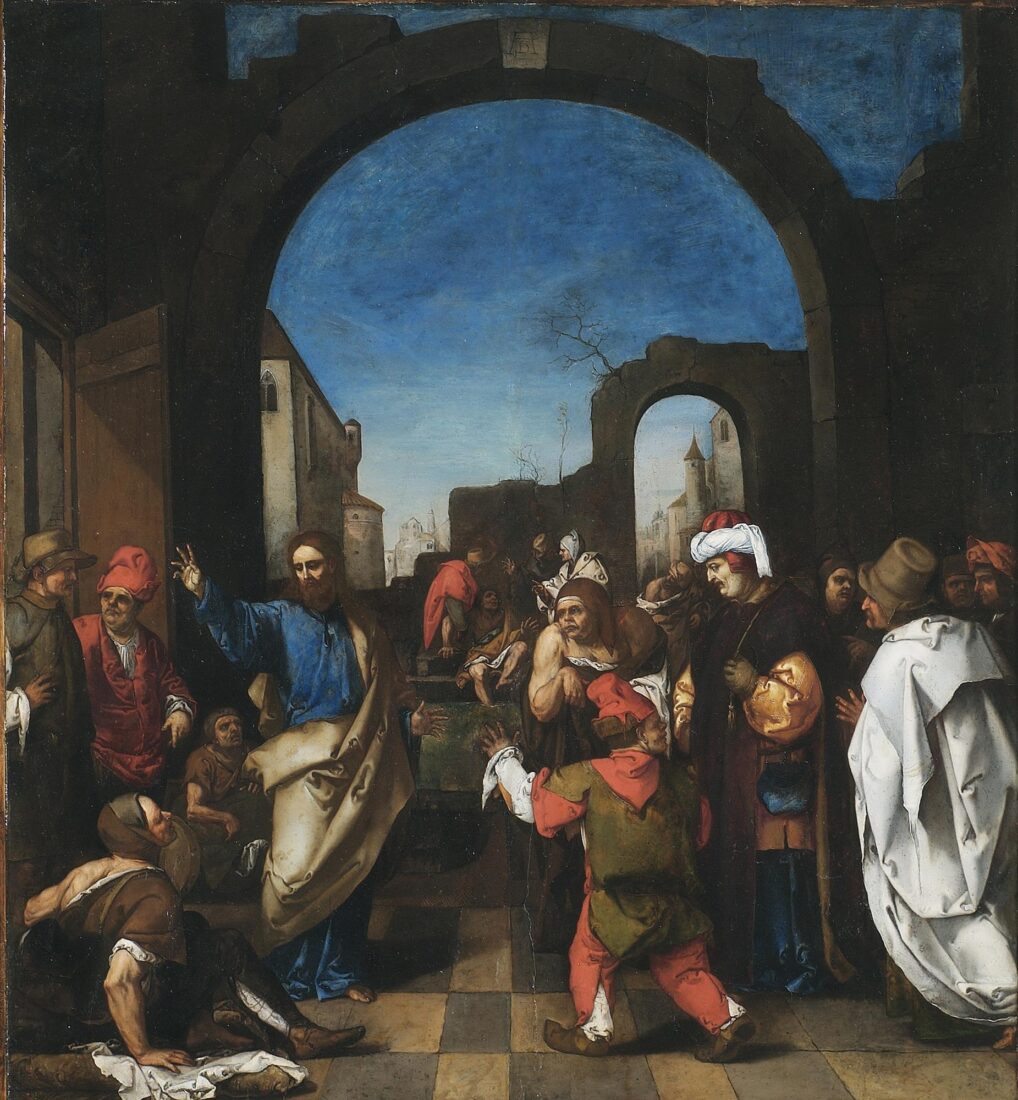We use cookies to make our site work properly, to personalize content and ads, to provide social media features and to analyze our traffic. We also share information about how you use our site with our social media, advertising and analytics partners. Read the Cookies Policy.

The Healing of the Lame, 1653
Oil on panel, 96 x 87 cm
In Bernardo de’ Dominici’s impressive and laudatory biography of Luca Giordano (which is included in Gian Pietro Bellori’s “Le vite de’ pittori, scultori et architetti moderni” and is considered a major historical source for Neapolitan Baroque painting), the author emphasizes the painter’s “enormous virtuosity” for copying the techniques of the great artists of the past. He writes that the Abbot of the Certosa Monastery of San Martino in Naples “insisted that Luca was capable of imitating every technique except for that of Albrecht Durer, whom he admired passionately and whose work he had purchased for the sum of 600 ducats. This painting depicted in great detail the story of the Adoration of the Magi. The experts had assured the Abbot that this was an authentic Durer. The Abbot, who boasted of the purchase in front of Luca, heard the latter say that he had painted this picture himself and to verify his claims showed him the place on the back of the panel where he had discreetly signed it. Feeling that he’d been defrauded, the Abbot sought justice, demanding reimbursement for the sum he’d paid for the work believing that it was a Durer, not a Giordano. The case reached the courts of the Royal Council, but Luca was acquitted because the judges recognized that his worth was as great as Durer’s. However, to placate the Abbot, Prince Sonnino purchased the work, which he liked at any rate, for the sum of 1600 ducats. To this day, the painting is shown to art lovers as a Durer, with the truth subsequently revealed truth as incontrovertible proof of Luca Giordano’s enormous talent. (“Vita del cavaliere D. Luca Giordano pittore napoletano”, Naples, 1729, p. 92).
Despite the debate over the painting’s subject and the location of the signature, art historian Wilhelm R. Valentiner, as well as most subsequent Giordano scholars, believes that this incident is related to the painting in the Bohler and Steinmeyer Collection in New York, which depicts the “Healing of the Paralytic”. As Valentiner describes it, the top part of the gate that frames the scene bears Durer’s familiar monogram, whereas the shadow on the left, written sideways so as to be concealed by the frame, contains Giordano’s signature (“An Early Forger,” Art in America, I, 1913, pp. 195-208). This painting then passed into the possession of an unknown owner to reappear at auction in Munich in 1933. Since then its whereabouts are unknown.
In 1967, the National Gallery purchased a painting by an unknown painter, entitled “The Pool of Siloam”. In 1968-69, Robert Lebel, who had been asked to appraise the Western European painting collection, attributed it to Francesco Villamena (1564-1624). But on a visit to the National Gallery in 1988, Professor Federico Zeri attributed it to an early work of Luca Giordano. Angela Tamvaki, the then curator of the National Gallery’s Western European painting collection, did additional research and began to suspect that it was the painting that Wilhelm R. Valentine referred to and published in 1913. This opinion was supported by Giuseppe de Vito, a Luca Giordano scholar and specialist of his early works, who instigated a laboratory investigation into the existence of a signature and date.
The scholars’ suspicions were confirmed and proven correct when, in 1997, an examination of the painting using infrared reflectography revealed the signature and date written on along the side concealed by the frame on the lower left margin of the painting. No trace, however, was found of the Durer initials added by Giordano. In July 2008, a cleaning by the National Gallery conservators uncovered the monogram on the upper portion, in the center of the arch, a fact that identifies this painting as the one mentioned by Valentiner.
The painting depicts the scene described in the Gospel according to John, of the healing of the paralytic at the pool at Bethzatha. According to John, from time to time an angel would agitate the waters of the pool at Bethzatha and the first person able to enter it would be cured of every affliction. The ill and lame would gather around the pool ready to jump in. But the paralytics were unable to pass ahead of the others and thus remained waiting their entire lives. Jesus performed the miracle of healing a paralytic in order for him to then enter the pool and complete his cure.
Christ on the left side of the painting with a gesture of blessing heals the paralyzed man who looks him in the eye as he struggles to stand up. The crowd around them, made up of the ill, relatives and passersby, observe the scene with curiosity. In the background, two men are supporting a patient emerging from the miraculous water. The void in the center foreground of the composition leads the viewer’s eye to the pool, the symbol of baptism through which Salvation is completed. The dominant reddish-brown palette creates a sense of hopelessness, whereas the blue of Christ’s mantle and the sky symbolize hope.
The 1997 examination of the painting with infrared reflectography revealed yet another surprise. There had been angel on the pool in the center background of the painting, who was agitating the water with his wand. It is not known why Giordano painted over the angel – perhaps to give more emphasis to Christ’s miracle – its form however remains on the work like an invisible presence.

